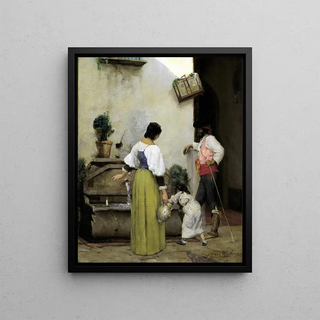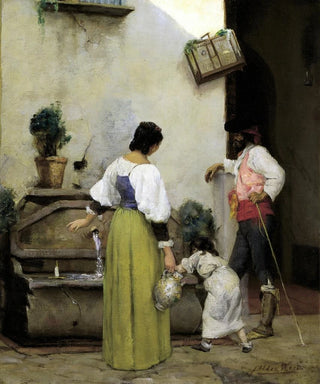Art print | At the drinking trough - Julian Alden Weir


View from behind

Frame (optional)
In a world where art blends with nature with poignant delicacy, "At the watering hole" by Julian Alden Weir stands as an emblematic work of American Impressionism. This canvas, imbued with serenity, invites the viewer to immerse themselves in a suspended moment, where time seems to expand around a bucolic scene. The depiction of a watering hole, a meeting place between man and animal, evokes a precious harmony with nature. Through this piece, Weir manages to capture the very essence of rural life, while offering a reflection on the interaction between humans and their environment.
Style and uniqueness of the work
Weir's work is distinguished by his masterful use of light and color, essential characteristics of Impressionism. In "At the watering hole," delicate shades of green and blue blend to create a lively and soothing atmosphere. The play of shadow and light, rendered with fluid brushstrokes, infuses a subtle movement into the frozen scene. Every detail, from the reflections in the water to the silhouettes of animals, is treated with meticulous care that reveals the artist's sensitivity. The composition, both simple and profound, allows the viewer to feel an immediate connection with the landscape, while also offering the opportunity to explore more complex emotions. This painting transcends mere realism to become a true ode to the beauty of nature.
The artist and his influence
Julian Alden Weir, a major figure of American Impressionism, skillfully combined tradition and innovation throughout his career. Trained at the École des Beaux-Arts in Paris, he was influenced by great European masters while developing a style that was uniquely his own. His ability to translate the nuances of light and the changing atmospheres of the American landscape made him a pioneer in his field. By incorporating elements of everyday life into his works, Weir paved the way for a new approach to art, where rural subjects and nature become inexhaustible sources of inspiration. His legacy endures through generations.

Matte finish

View from behind

Frame (optional)
In a world where art blends with nature with poignant delicacy, "At the watering hole" by Julian Alden Weir stands as an emblematic work of American Impressionism. This canvas, imbued with serenity, invites the viewer to immerse themselves in a suspended moment, where time seems to expand around a bucolic scene. The depiction of a watering hole, a meeting place between man and animal, evokes a precious harmony with nature. Through this piece, Weir manages to capture the very essence of rural life, while offering a reflection on the interaction between humans and their environment.
Style and uniqueness of the work
Weir's work is distinguished by his masterful use of light and color, essential characteristics of Impressionism. In "At the watering hole," delicate shades of green and blue blend to create a lively and soothing atmosphere. The play of shadow and light, rendered with fluid brushstrokes, infuses a subtle movement into the frozen scene. Every detail, from the reflections in the water to the silhouettes of animals, is treated with meticulous care that reveals the artist's sensitivity. The composition, both simple and profound, allows the viewer to feel an immediate connection with the landscape, while also offering the opportunity to explore more complex emotions. This painting transcends mere realism to become a true ode to the beauty of nature.
The artist and his influence
Julian Alden Weir, a major figure of American Impressionism, skillfully combined tradition and innovation throughout his career. Trained at the École des Beaux-Arts in Paris, he was influenced by great European masters while developing a style that was uniquely his own. His ability to translate the nuances of light and the changing atmospheres of the American landscape made him a pioneer in his field. By incorporating elements of everyday life into his works, Weir paved the way for a new approach to art, where rural subjects and nature become inexhaustible sources of inspiration. His legacy endures through generations.






